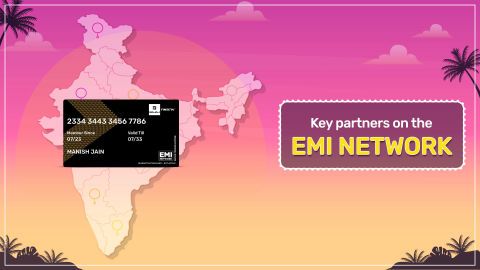3 min
6 March 2025
Smartphone displays have evolved significantly, with POLED and AMOLED being two of the most popular technologies in modern devices. Both offer exceptional colour accuracy, deep blacks, and energy efficiency, but they differ in structure and durability. POLED displays use a plastic substrate for flexibility, while AMOLED relies on glass, offering sharp visuals with better longevity. The choice between these two depends on user preference, durability, and viewing experience. Let’s explore POLED and AMOLED to determine which one is better for different usage needs. Explore POLED and AMOLED display smartphones on the Bajaj Mall website or visit one of 1.5 lakh Bajaj Finserv partner stores across 4,000+ cities in India. Shop on Easy EMIs on the Bajaj Finserv EMI Network, which has benefits like zero down payment and free home delivery on select products.
POLED vs AMOLED: Which one is better
Choosing between POLED and AMOLED which is better depends on display quality, durability, and efficiency. While the AMOLED display offers deeper blacks and vivid colours with glass-based panels, POLED display uses plastic substrates for better flexibility and lightweight design. Both technologies enhance viewing experiences, but AMOLED vs POLED differs in longevity and resistance to wear. Understanding their strengths helps in making an informed decision. Explore the latest AMOLED display phones to experience superior visual quality at an affordable price. Learn more on the Bajaj Mall website or visit one of 1.5 lakh+ stores across 4,000+ cities in India. After you select the product based on your requirements, choose a preferred repayment tenure between 1 month to 60 months and shop on Easy EMIs.
Panel structure – POLED uses a plastic substrate instead of the glass found in AMOLED, making it more flexible and lightweight.
Durability – POLED displays are more resistant to drops and impacts due to their plastic material, whereas AMOLED panels may crack easily.
Flexibility – POLED screens can be curved or folded, making them ideal for foldable and edge-display smartphones, unlike AMOLED’s rigid design.
Image quality – AMOLED panels generally provide better brightness and colour accuracy due to advanced manufacturing processes, offering superior visual performance.
Longevity – AMOLED panels tend to last longer as they are less prone to screen degradation compared to POLED.
Cost of production – POLED displays are more cost-effective to manufacture, which allows brands to offer high-quality visuals at a lower price point.
Manufacturers – POLED is mainly used by LG and Motorola, whereas AMOLED is produced by Samsung and found in many flagship devices.
Power efficiency – AMOLED panels use advanced pixel control that turns off unused pixels, consuming less power compared to POLED, which has slightly higher power draw.
Refresh rate capabilities – High-end AMOLED displays can support higher refresh rates for smoother scrolling and gaming, whereas POLED screens may struggle with ultra-high refresh rates.
Brightness levels – AMOLED panels achieve higher peak brightness, making them more visible under direct sunlight, while POLED may appear dimmer outdoors.
Colour accuracy – AMOLED screens are known for deep blacks and rich colour saturation, while POLED panels can sometimes appear slightly muted.
Burn-in risk – Both displays are susceptible to screen burn-in, but POLED has a slightly higher tendency due to plastic materials retaining images longer.
Flexibility for design – POLED’s flexibility allows manufacturers to experiment with unique form factors, whereas AMOLED is commonly used in rigid panels.
Usage in wearables – Many smartwatches and foldable devices prefer POLED for its lightweight and flexible properties, while AMOLED remains dominant in premium smartphones.
AMOLED panels have been refined over time, making them more common in high-end devices, whereas POLED is used in more experimental designs. While both displays provide a great viewing experience, AMOLED generally holds an edge in colour accuracy and longevity, while POLED is better suited for innovative form factors.
Ultimately, the choice comes down to individual needs. Users looking for a premium visual experience with excellent colour reproduction may prefer AMOLED, whereas those interested in durability and flexible design may find POLED more suitable. Both technologies continue to evolve, bringing enhanced displays to modern smartphones and wearable devices.
Easy EMIs: With theBajaj Finserv Insta EMI Card, buying your desired product becomes hassle-free. Choose a preferred tenure between 1 month to60 months and repay in Easy EMIs.
Zero down payment: Forget about the hassles of an initial lump sum payment as select products are covered under the zero down payment policy.
Options and accessibility: Buying your favourite products have never been this easy! The Bajaj Finserv EMI Network hosts over 1 million products, available at 1.5 lakh+ partner stores, across 4,000+ cities.
Exciting deals and cashback offers: By shopping on the Bajaj Finserv EMI Network, you gain access to exciting deals and cashback offers.
Free home delivery: To add to your convenience, select products are delivered free of cost.
POLED vs AMOLED: What is the difference between these OLED technologies
Smartphone displays have advanced significantly, with POLED and AMOLED being two widely used OLED technologies. Both deliver vibrant colours, deep blacks, and energy efficiency, but their core differences lie in construction and flexibility. Understanding these differences helps users decide which display suits their needs better.Panel structure – POLED uses a plastic substrate instead of the glass found in AMOLED, making it more flexible and lightweight.
Durability – POLED displays are more resistant to drops and impacts due to their plastic material, whereas AMOLED panels may crack easily.
Flexibility – POLED screens can be curved or folded, making them ideal for foldable and edge-display smartphones, unlike AMOLED’s rigid design.
Image quality – AMOLED panels generally provide better brightness and colour accuracy due to advanced manufacturing processes, offering superior visual performance.
Longevity – AMOLED panels tend to last longer as they are less prone to screen degradation compared to POLED.
Cost of production – POLED displays are more cost-effective to manufacture, which allows brands to offer high-quality visuals at a lower price point.
Manufacturers – POLED is mainly used by LG and Motorola, whereas AMOLED is produced by Samsung and found in many flagship devices.
POLED vs AMOLED: Other panel differences
Beyond structural differences, POLED and AMOLED panels vary in areas like power consumption, viewing experience, and overall usability. These factors affect how a display performs under different conditions.Power efficiency – AMOLED panels use advanced pixel control that turns off unused pixels, consuming less power compared to POLED, which has slightly higher power draw.
Refresh rate capabilities – High-end AMOLED displays can support higher refresh rates for smoother scrolling and gaming, whereas POLED screens may struggle with ultra-high refresh rates.
Brightness levels – AMOLED panels achieve higher peak brightness, making them more visible under direct sunlight, while POLED may appear dimmer outdoors.
Colour accuracy – AMOLED screens are known for deep blacks and rich colour saturation, while POLED panels can sometimes appear slightly muted.
Burn-in risk – Both displays are susceptible to screen burn-in, but POLED has a slightly higher tendency due to plastic materials retaining images longer.
Flexibility for design – POLED’s flexibility allows manufacturers to experiment with unique form factors, whereas AMOLED is commonly used in rigid panels.
Usage in wearables – Many smartwatches and foldable devices prefer POLED for its lightweight and flexible properties, while AMOLED remains dominant in premium smartphones.
Conclusion
Choosing between POLED and AMOLED depends on priorities such as display quality, durability, and flexibility. POLED offers advantages in lightweight design, flexibility, and impact resistance, making it ideal for foldable and curved screens. On the other hand, AMOLED delivers superior brightness, colour accuracy, and power efficiency, making it the preferred choice for flagship smartphones.AMOLED panels have been refined over time, making them more common in high-end devices, whereas POLED is used in more experimental designs. While both displays provide a great viewing experience, AMOLED generally holds an edge in colour accuracy and longevity, while POLED is better suited for innovative form factors.
Ultimately, the choice comes down to individual needs. Users looking for a premium visual experience with excellent colour reproduction may prefer AMOLED, whereas those interested in durability and flexible design may find POLED more suitable. Both technologies continue to evolve, bringing enhanced displays to modern smartphones and wearable devices.
Shop for POLED and AMOLED display phones on Easy EMIs from Bajaj Finserv
Bajaj Mall is the best online destination to read about all the details, features, and specs of your desired product. Once you have gathered all the information you want, head to the nearest Bajaj Finserv partner store and select the product you want. Check your eligibility and submit your basic details to get an instant loan offer. Now, you can choose a convenient repayment tenure and purchase the product on Easy EMIs.Advantages of shopping with Bajaj Finserv
Competitive prices: Bajaj Finserv partner stores offer competitive pricing, ensuring that your purchase is budget-friendly.Easy EMIs: With theBajaj Finserv Insta EMI Card, buying your desired product becomes hassle-free. Choose a preferred tenure between 1 month to60 months and repay in Easy EMIs.
Zero down payment: Forget about the hassles of an initial lump sum payment as select products are covered under the zero down payment policy.
Options and accessibility: Buying your favourite products have never been this easy! The Bajaj Finserv EMI Network hosts over 1 million products, available at 1.5 lakh+ partner stores, across 4,000+ cities.
Exciting deals and cashback offers: By shopping on the Bajaj Finserv EMI Network, you gain access to exciting deals and cashback offers.
Free home delivery: To add to your convenience, select products are delivered free of cost.
Frequently asked questions
Is the POLED better than AMOLED?
POLED is better in terms of flexibility and durability, as it uses a plastic substrate instead of glass. However, AMOLED offers superior brightness, colour accuracy, and power efficiency. The choice depends on whether a user prioritises durability and lightweight design (POLED) or better display quality and longevity (AMOLED).
Is POLED good for the eyes?
POLED displays reduce blue light emission compared to traditional LCDs, making them less straining on the eyes. However, AMOLED displays with blue light filters and adaptive brightness controls tend to be more eye-friendly, especially for extended usage in low-light environments.
What is better than AMOLED?
MicroLED and LTPO OLED are considered advancements over AMOLED. MicroLED offers better brightness, longevity, and efficiency without burn-in risks, while LTPO OLED improves power efficiency by dynamically adjusting the refresh rate. However, these technologies are still in early adoption stages compared to AMOLED.
Is the iPhone POLED or AMOLED?
Most iPhones use AMOLED displays, primarily manufactured by Samsung. Apple introduced OLED panels with the iPhone X and has continued using AMOLED technology in its high-end models, providing better brightness, contrast, and power efficiency compared to POLED alternatives.
Is AMOLED harmful to the eyes?
AMOLED displays can cause eye strain if used at high brightness levels for long periods. However, features like blue light filters, night mode, and adaptive brightness settings help reduce strain. Compared to LCDs, AMOLED screens emit less blue light, making them a better choice for eye comfort.
Show More
Show Less
Bajaj Finserv App for all your financial needs and goals
Trusted by 50 million+ customers in India, Bajaj Finserv App is a one-stop solution for all your financial needs and goals.
You can use the Bajaj Finserv App to:
Apply for loans online, such as Instant Personal Loan, Home Loan, Business Loan, Gold Loan, and more.
You can use the Bajaj Finserv App to:
Apply for loans online, such as Instant Personal Loan, Home Loan, Business Loan, Gold Loan, and more.
- Explore and apply for co-branded credit cards online.
- Invest in fixed deposits and mutual funds on the app.
- Choose from multiple insurance for your health, motor and even pocket insurance, from various insurance providers.
- Pay and manage your bills and recharges using the BBPS platform. Use Bajaj Pay and Bajaj Wallet for quick and simple money transfers and transactions.
- Apply for Insta EMI Card and get a pre-approved limit on the app. Explore over 1 million products on the app that can be purchased from a partner store on Easy EMIs.
- Shop from over 100+ brand partners that offer a diverse range of products and services.
- Use specialised tools like EMI calculators, SIP Calculators
- Check your credit score, download loan statements, and even get quick customer support—all on the app.












